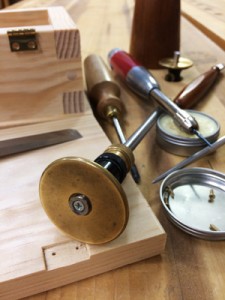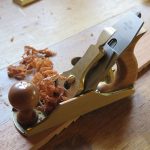We may receive a commission when you use our affiliate links. However, this does not impact our recommendations.
 Woodworking tool design progresses slowly. While it’s easy to state that today we have some of the best woodworking tools ever, the designs haven’t changed much. I mean, when a manufacturer takes advantage of modern metallurgy and manufacturing processes you can get some exceptionally high-quality tools – but that isn’t design change.
Woodworking tool design progresses slowly. While it’s easy to state that today we have some of the best woodworking tools ever, the designs haven’t changed much. I mean, when a manufacturer takes advantage of modern metallurgy and manufacturing processes you can get some exceptionally high-quality tools – but that isn’t design change.
Saws still have teeth shaped the same way, blades and backs of the same size and shape, and even handle designs (while a little larger on average) are the same shape as many in the historic record. The advances have been more in materials used and machining tolerances than in overall design.
That situation is even more obvious in the handplane realm. Shoot – even Lie-Nielsen states their planes are refined Bedrocks or other Stanleys.
The same can be said in the power-tool world, if you limit the scope to the realm of small shops or hobbyists. There have been exceptional leaps in the commercial woodworking world with CNC, laser cutters and water jets, but those are realistically out of the reach of most.
Because of another project, I’ve been thinking of design quite a bit this past week. This lack of radical innovation seems somewhat specific to the woodworking world. I know that automobiles have advanced and changed more from about 1985 to the turn of the 21st century than they did from the turn of the 20th century to 1985, mainly due to computerization. Medicine…don’t get me started. Even some of the most basic functions such as cooking have had major innovations in the past 30-40 years (microwaves, MREs, ceramics).
For the life of me, I was having a difficult time thinking of a modern woodworking tool design that has “stuck.” Seriously – I’d contemplated this for a few days and it was frustrating me. With all the advances we have had in my lifetime, basic woodworking tools haven’t changed much and I couldn’t figure out why.
And then, while installing some hinges, I found one: a design so perfect that its use is intuitive and practically disappears into your workflow with no thought. A tool that betters the performance of the design it replaces and brings along so much more.
I think brass wheel marking gauges, epitomized by the Tite-Mark, are radically different enough from traditional gauges that they might represent the biggest advance in woodworking tool design this century. Sure it’s a shaft and a head, but the function, shape and usage is so different than that of traditional marking gauges that it is a totally new design. The biggest advantages to the wheel marking gauge are, in my opinion, the adjustability, thin shaft and flush head.
It used to be that all a gauge did was mark a line, and the adjustments were kinda of crude. But now, how many of us use these flexible tools for measuring or cutting without a second thought. I know mine is used with every mortise to verify my tenon length, and it has become my de facto router plane when working on small things, such as hinge gains. The flush cutter head is easily sharpened and, due to the bevel, can be used just as effectively as a plane to level narrow dados, rabbets and grooves. I’m actually surprised nobody has developed different-shaped replacement carbide heads for these tools for that purpose.
And can we talk about accuracy and adjustability? They say that quality design is practically invisible – so simple and elegant as to be intuitive. I can put these tools into students’ hands and instantly they’re making fine adjustments and figuring out uses. With the old wooden rod and screw (or wedge) it was a bit hit-and-miss with accuracy. The tool was finicky, which adds frustration and requires instruction. Not so with this new design.
And to think: The design less than 20 years old yet now ubiquitous.
Can you think of a modern tool design that has infiltrated the woodworking community more that the brass wheel marking gauge?
— Shawn Graham
Here are some supplies and tools we find essential in our everyday work around the shop. We may receive a commission from sales referred by our links; however, we have carefully selected these products for their usefulness and quality.









Here is one new design that should have been here 20 years ago – a pneumatic nailer that shoots hardened wooden nails with friction activated glue coating. will be as strong as glue and screwing, much much faster and easier, and you can recycle and cut the material without fear for the safety of your blades or your eyes. used to be everything was done with nails at the lower end of the market, and everything could be fixed and reuse. with todays commercial shops using metal neumatic fasteners for speed and cost effocoency, almost all their work is unreparable and unreusable, contributing a huge amunt of stuff to the landfills every year. this is something I amreally looking forward to.
As long as we are talking horse in the game how a about the lock miter router bit and the Infinity Lock Miter Master which finally makes the setup easy. While we are at it, how about the INCRA I-BOX box joint jig?
Uuuuummmmm; how old are pneumatic nailers?
Depends on the iconic word, “New.” I guess. Router motors, invented in 1915, began to take over hand routing about a decade after Orville and Wilbur Wright were re imagining the bicycle and kite into powered flight (1903 Kittyhawk, SC).
Woodworking, in a practical way, is bounded by some real and ubiquitous constraints. People do not want gigantic wooden things so much. A log home is arguably the largest item in demand. Wood comes in the size of trees, not much bigger, but from tree size down. Hughes had the Spruce Goose built but from its inception that was destined to be a “one off.”
It is probably fair to argue that some of the “new” materials, worked with essentially wood working equipment, shows that wood working is morphing into soft materials working. Frankly, metal working was significantly influenced by wood working, both in the techniques used to fabricate and by the demand placed upon metal equipment to work wood.
I admit that I have a horse in this race.
Almost every tool used in woodworking is built on the collection of tools that reaches back thousands of years. Many current designs can be traced back to the pictographs drawn on the walls of the pyramids.
Rarely does a design break new ground, but instead represents an incremental improvement. This can be caused by a change in manufacturing technique (such as CNC) where it is possible to provide multiple variations in the same tool that would not have been economically possible heretofore.
Fret and Coping saws have remained unchanged for well over 200 years, and had simply become a commodity. I felt that they were inherently weak and were too heavy, so I designed a bridge truss ‘C’ frame. They have been accepted around the world, with distributors in Germany, Japan, France, Canada and the U.S. They are made in the U.S. with pride.
Lee (the saw guy)
The Stanley 97 dates to 1907. I have a Leavitt Mach. Co. dual arm, recessed head, round cutter gauge w/ patent date of 1888. I also have an un-marked gauge, similar to the Starrett #29B, that has a micro adjuster like that on a micrometer. From its wear and patina, I am guessing it dates to the early part of the 20th C. I must admit, however, that using one of these gauges as a mini-router is a new idea.
Odd that you were installing hinges when you overlooked the very tool you were likely using.
Vix bits – 1958
Off the top of my head, other advances include:
Impact Drivers
Cordless tools
Drill/Drivers
Router lifts
Oscillating multi-tools
Track Saws
Microplane Rasps
Parallel Clamps
Vacuum presses
You’ll see a fair bit of innovation coming from Bridge City Toolworks. But when you get down to it, the truth is that woodworking consists of measuring, marking, cutting wood, and then reassembling it. These are tasks that we’ve been doing for THOUSANDS of years. Using lasers to measure really isn’t necessary given the small size of our projects. Ditto for marking. So most of the advances have come in the cutting and reassembling areas.
Until we come up with mono molecular edge blades and light saber based plane technology, there’s not really a lot of different ways of presenting a cutting edge to wood, especially when dealing with human powered tools. Sure, you could do a plane that uses an electro-magnetic or hydraulic frog, allowing infinitely variable pitch. Be pretty cool technology for sure, but all you’re doing is allowing the user to twiddle a dial to change pitch, rather than putting the plane on a shelf and grabbing a different one with the desired pitch.
CNC is simply the application of computers to the cutting process, and it is coming to the home shop. On reassembly you have biscuit joiners, Domino, parallel clamps, legions of new adhesives, and vacuum presses are just the ones of which I’m aware.
Just a few off the top of my head: Kreg pocket hole jig, diamond stones and pastes, and sketchup. Waterbased finishes are a nice new developement too.
Easy “Domino.”
As soon as the patent expires, you’ll see it permeate the woodworking world in short order, I’m sure every power hand tool maker out there wants to have one in their line.
Routers are only 100 yrs old this year (according to wikipedia)
Sliding compound miter saws have been pretty revolutionary.
Also, Stanley made the 97 http://www.jonzimmersantiquetools.com/tools/97_gauge_b.jpg so the wheel gauges aren’t exactly “something new under the sun”. Not trying to take anything away from those sweet tite-marks though.
Great question! Off the top of my head: Diamond stones and pastes. And although not hand tool related, sketch-up and water based finishes and sprayers.